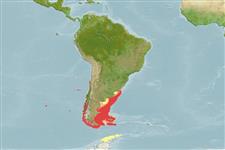Common names from other countries
Classification / Names / Names
俗名 | 同種異名 | Catalog of Fishes (gen., sp.) | ITIS | CoL | WoRMS
Environment: milieu / climate zone / depth range / distribution range
生態學
; 深度上下限 1 - 270 m (Ref. 87801), usually 70 - 120 m (Ref. 114844). , preferred 8°C (Ref. 107945); 26°S - 65°S, 110°W - 53°W
Southeast Pacific, Southwest Atlantic and Antarctic: Magellanic biogeographic province. In the Pacific from Puerto Montt to Strait of Magellan and Cape Horn (56°S) to the Atlantic northwards to Rio de la Plata estuary (35°S). Also from Palmer Archipelago, Antarctica and Easter Island. Introduced in the Mediterranean. Subtropical to polar.
Length at first maturity / 大小 / 重量 / 年齡
Maturity: Lm ? range ? - ? cm Max length : 7.8 cm SHL 雄魚/尚未辨別雌雄; (Ref. 83435)
The Patagonian scallop fishery of this species has been certified by the Marine Stewardship Council (http://www.msc.org/) as well-managed and sustainable (http://www.msc.org/html/content_1294.htm). This is an epifaunal species found at depths of 1 to 270 meters. Adults live on the bottom supported by their right valve while juveniles appear as epibionts of algae and other invertebrates. Single species found in shallow waters and forms large banks in deeper waters. Larvae are free-living (Ref. 87801). It is found in forests of Macrocystis pyrifera (Ref. 92889).
Life cycle and mating behavior
成熟度 | 繁殖 | 產卵場 | 卵 | 孕卵數 | 仔魚
Members of the class Bivalvia are mostly gonochoric, some are protandric hermaphrodites. Life cycle: Embryos develop into free-swimming trocophore larvae, succeeded by the bivalve veliger, resembling a miniature clam.
主要參考資料
參考文獻 | 合作者 | 合作者
Rosenberg, G. 2009. (Ref. 83435)
IUCN 瀕危狀態 (Ref. 130435)
CITES狀態 (Ref. 108899)
Not Evaluated
Not Evaluated
對人類具威脅
人類使用
漁業: 商業性
FAO - 漁業: landings | FishSource | 周邊海洋
工具
網路資源
Estimates based on models
回復力
高度, 族群倍增時間少於 15個月 (K=0.19-0.62).
Prior r = 0.57, 95% CL = 0.37 - 0.85, Based on 1 data-limited stock assessment.
